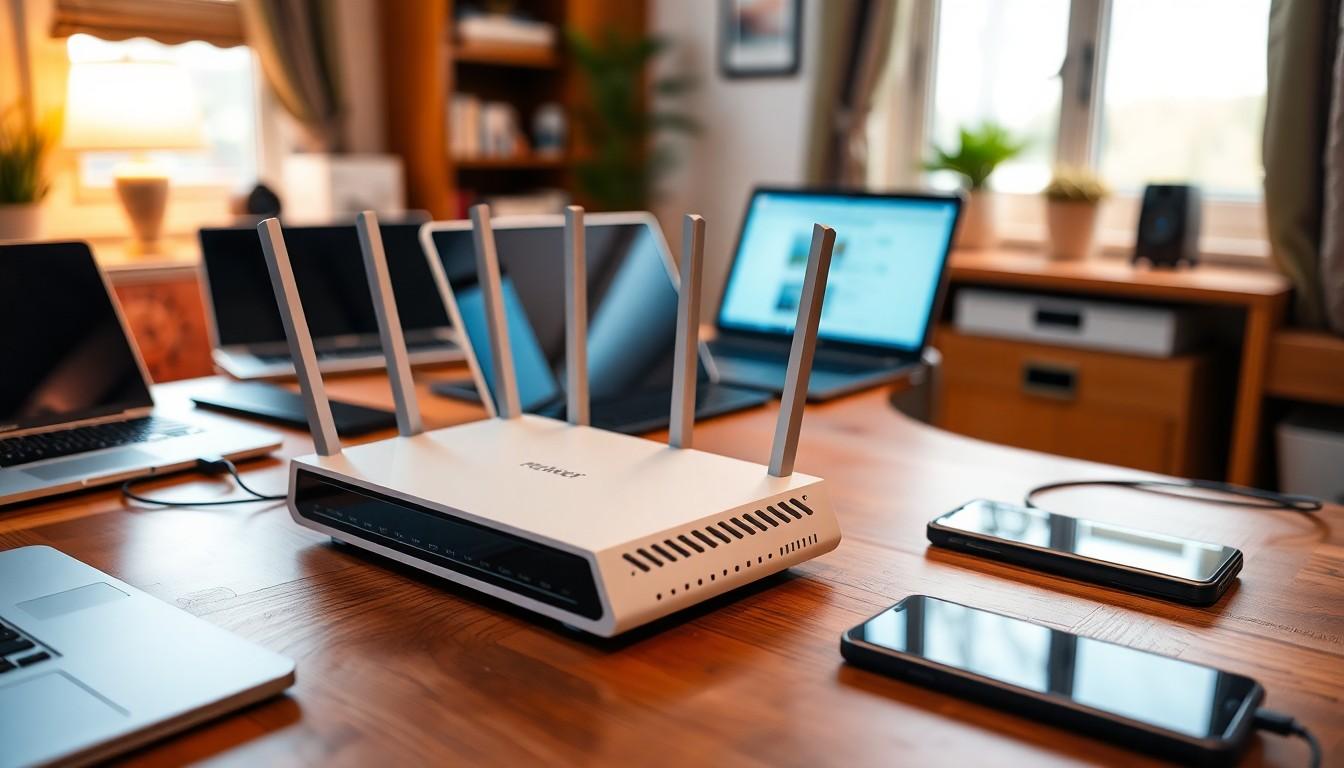In today’s digital age, a reliable home network isn’t just a luxury—it’s a necessity. Imagine trying to stream your favorite show only to have it buffer like it’s stuck in a time warp. Frustrating, right? Setting up a home network might sound daunting, but it’s easier than finding a pair of matching socks in a laundry pile.
Table of Contents
ToggleUnderstanding Home Networking
A reliable home network supports seamless connectivity and enhances digital experiences. Understanding its components and types helps in setting up an efficient network.
Key Components of a Home Network
Router manages data traffic between devices and the internet. Switch connects multiple devices within a local network. Modem enables internet access by connecting to the service provider. Wi-Fi extenders extend coverage, ensuring connectivity in larger spaces. Network cables transmit data directly, facilitating stable connections for devices that require it.
Types of Home Networks
Wired networks use Ethernet cables for direct connections, offering better speed and reliability. Wireless networks provide convenience by using Wi-Fi technology, allowing devices to connect without cables. Hybrid networks combine wired and wireless options, maximizing coverage and flexibility. Mesh networks improve signal strength, using multiple nodes to blanket a home in coverage. Each type serves different needs, catering to various configurations and preferences.
Steps for Setting Up Home Networking

Setting up a home network involves several key steps. Each step helps create a reliable and efficient digital environment.
Choosing the Right Internet Service Provider
Selecting the right Internet Service Provider (ISP) significantly affects network performance. ISPs offer various plans, with speed options tailored to different needs. Consider the number of devices connecting to the network, as higher speeds accommodate more users. Reviewing customer reviews and service reliability can aid in making an informed choice. Additionally, check for availability based on your location, as not all providers serve every area. Comparing prices, data caps, and contracts offers further insight into the best fit.
Selecting Network Hardware
Selecting appropriate network hardware is essential for effective connectivity. A router acts as the central hub for managing traffic between devices. Opt for a dual-band or tri-band router to maximize performance in larger homes. Network switches expand wired connections, proving useful for desktop computers or gaming consoles requiring stable access. Wi-Fi extenders can enhance coverage in larger spaces, ensuring consistent signals throughout. Additionally, investing in quality Ethernet cables can improve data transfer rates for wired connections. Prioritize hardware compatibility with the chosen ISP for optimal functionality.
Configuring Your Home Network
Configuring a home network involves setting up key devices and ensuring a secure connection. Understanding each component’s role is essential for optimizing performance.
Setting Up the Router
First, place the router in a central location for better coverage. Power it on and connect it to the modem using an Ethernet cable. Next, access the router’s settings through a web browser by entering the router’s IP address. Changing the default network name and password enhances security. Enabling dual-band functionality allows for improved connections with both 2.4 GHz and 5 GHz bands. Position antennas for maximum signal strength and consider updating the firmware to improve performance and security.
Configuring Network Security
Securing the home network prevents unauthorized access. Begin by choosing a strong password, ideally a mix of letters, numbers, and symbols. Enable WPA3 encryption for robust protection against potential threats. Regularly update the router’s firmware, as updates often contain important security patches. Disabling guest networks adds an extra layer of safety, limiting access to devices. Consider creating a separate network for smart home devices to further isolate sensitive information. Using a VPN can add an additional level of privacy and security during online activities.
Troubleshooting Common Networking Issues
Home networks may encounter various issues that can disrupt connectivity and slow down performance. Understanding how to identify and resolve common problems can enhance the user experience.
Connection Problems
Connection problems often manifest as intermittent drops or a complete lack of access. Begin troubleshooting by restarting the router and modem as this can resolve minor glitches. Checking cables for any wear or damage is essential, as faulty connections can lead to disruptions. Devices such as smartphones and laptops should have their Wi-Fi settings verified to ensure they’re connected to the correct network. Additionally, strengthening the Wi-Fi signal through repositioning the router or using extenders helps eliminate dead zones that may cause disconnections.
Slow Internet Speed
Slow internet speeds can frustrate users, impacting activities such as streaming or gaming. Start by running a speed test to determine if the network meets the promised speeds from the Internet Service Provider. If speeds fall short, consider limiting the number of devices connected simultaneously, as bandwidth can be stretched thin. Updating router firmware enhances performance and fixes potential bugs. Prioritizing connection types also matters; using wired connections for high-demand devices offers stability and speed advantages. Lastly, disabling background apps that consume data ensures better speed for prioritized activities.
Establishing a reliable home network is crucial for a seamless digital experience. By carefully selecting the right ISP and investing in quality hardware, users can create a setup that meets their unique needs. Configuring the network with attention to security and performance ensures that devices remain connected and protected.
Troubleshooting common issues further enhances connectivity, allowing users to enjoy uninterrupted streaming and online activities. With the right approach, anyone can transform their home networking experience into one that’s efficient and dependable. Embracing these strategies will empower users to navigate the digital landscape with confidence.





